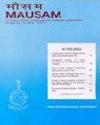Seasonal characterization of aerosols over high altitude location of southern India, Ooty, Tamilnadu
IF 0.7
4区 地球科学
Q4 METEOROLOGY & ATMOSPHERIC SCIENCES
引用次数: 0
Abstract
Climate change has been worsened by aerosols which got a significant place in the scientific research to understand climate change dynamics. Hence, the optical properties of the aerosols play an important role in the earth’s energy radiation budget. The Aerosol Optical Depth was measured at high altitude region in Ooty from December 2020 to May 2021. The spectral, monthly and diurnal variation of AOD were assessed and showed their seasonal variability. The mean AOD value at 500 nm was higher during the Summer season (0.625±0.323) than in the Winter season (0.213±0.006). The Black Carbon (BC) was measured using an Aethalo meter from December 2020 to September 2021. The average season wise concentrations of BC were 0.680±0.206µg m-3, 1.128±0.393 µg m-3 and 0.189±0.06 µg m-3 for the Winter, Summer and Monsoon seasons, respectively. The sources of BC mass concentration were apportioned based on fossil fuel (BCff) and biomass burning (BCbb). The fossil fuel based contribution was higher than the biomass based contribution to the total BC concentration. The comparative study of BC concentration with the AOD, it was projected that the AOD had increased in line with surging BC concentration up to April, 2021. The ground-based daily AOD measurements were compared with the MODIS retrieved AOD. The MODIS retrieved AOD was positively correlated with the ground measured AOD during the Winter and Summer seasons. The HYSPLIT trajectory presented the pathways of the source from the long range regions. The Winter season trajectory was attributed to the North-easterly and easterly winds and the Summer season was attributed to the North-westerly and westerly winds that exhibited the long-range transport of aerosols from the neighbouring cities. The meteorological parameters significantly affected the loading of aerosols during all the seasons, denoting that they were supposed to the local prevailing meteorological conditions.印度南部泰米尔纳德邦奥蒂高空气溶胶的季节特征
气溶胶加剧了气候变化,在了解气候变化动态的科学研究中占有重要地位。因此,气溶胶的光学特性在地球能量辐射预算中发挥着重要作用。2020 年 12 月至 2021 年 5 月期间,在奥蒂的高海拔地区测量了气溶胶光学深度。对 AOD 的光谱、月变化和日变化进行了评估,并显示出其季节性变化。夏季 500 nm 处的平均 AOD 值(0.625±0.323)高于冬季(0.213±0.006)。2020 年 12 月至 2021 年 9 月期间,使用 Aethalo 测量仪对黑碳(BC)进行了测量。冬季、夏季和季风季节的 BC 平均浓度分别为 0.680±0.206µg m-3、1.128±0.393 µg m-3 和 0.189±0.06 µg m-3。化石燃料(BCff)和生物质燃烧(BCbb)是 BC 质量浓度的来源。在 BC 总浓度中,化石燃料的贡献率高于生物质的贡献率。通过对 BC 浓度与 AOD 的比较研究,预计到 2021 年 4 月,AOD 与激增的 BC 浓度保持一致。对地基每日日照时数的测量值与 MODIS 的日照时数进行了比较。在冬季和夏季,中分辨率成像分 辨系统获取的 AOD 与地面测量的 AOD 呈正相关。HYSPLIT 轨迹显示了来自远距离区域的源路径。冬季的轨迹归因于东北风和东风,而夏季则归因于西北风和西风,这显示了气溶胶从邻近城市的长程飘移。气象参数对所有季节的气溶胶负荷都有重大影响,这表明气溶胶负荷与当地盛行的气象条件有关。
本文章由计算机程序翻译,如有差异,请以英文原文为准。
求助全文
约1分钟内获得全文
求助全文
来源期刊

MAUSAM
地学-气象与大气科学
CiteScore
1.20
自引率
0.00%
发文量
1298
审稿时长
6-12 weeks
期刊介绍:
MAUSAM (Formerly Indian Journal of Meteorology, Hydrology & Geophysics), established in January 1950, is the quarterly research
journal brought out by the India Meteorological Department (IMD). MAUSAM is a medium for publication of original scientific
research work. MAUSAM is a premier scientific research journal published in this part of the world in the fields of Meteorology,
Hydrology & Geophysics. The four issues appear in January, April, July & October.
 求助内容:
求助内容: 应助结果提醒方式:
应助结果提醒方式:


